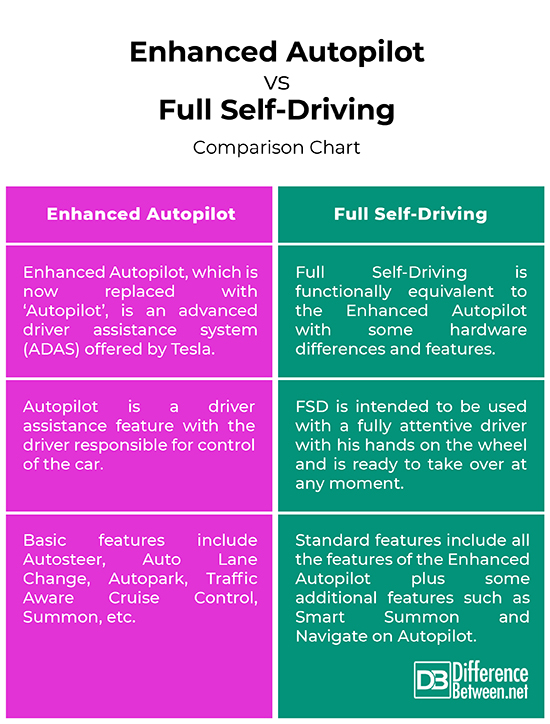Difference Between Enhanced Autopilot and Full Self Driving
The latest technological innovations are radically transforming the transportation sector, creating the foundation for mobility solutions. Today the biggest challenge of innovation in the transport sector is represented by automation of vehicles. Autonomous vehicle (AV) technology offers the possibility of fundamentally challenging transportation. The leading car manufacturers as well as new players in the automotive industry are working to commercialize fully Connected and Automated Vehicles (CAVs) by 2030. Assistance systems are the cornerstone for automated driving, which affects every aspect of the vehicle, such as powertrain, brakes and steering.
There are six levels of automation defined in standards by the International Society of Automotive Engineers (SAE): Level 0 (No Automation), Level 1 (Driver Assistance), Level 2 (Partial Automation), Level 3 (Conditional Automation), Level 4 (High Automation), and Level 5 (Full Automation). These standards have been adopted by the National Highway Traffic Safety Administration (NHTSA) and accepted by major stakeholders in the automotive sector. In its current form, Autopilot is an advanced driver assistance system (ADAS) that classifies as a Level 2 automated system, giving drivers more confidence behind the wheel. Enhanced Autopilot includes the basic Autopilot features plus some additional features. The full self-driving automation is yet to be seen, however, Tesla claims that its current system will be upgraded soon to provide full self-driving automation feature in the coming future.
What is Enhanced Autopilot?
Autopilot is an advanced driver assistance system (ADAS) feature offered by Tesla. It classifies as a Level 2 automated system that includes some nice automated features such as adaptive cruise control, lane keep assist, autosteer, selfpark, and more. It also has the ability to automatically change lanes without requiring driver steering, and enables the vehicle to be summoned to and from a parking spot. It still is considered a driver’s assistance feature where the driver remains in control of vehicle at all times. Tesla’s Model S already includes an autopilot mode where the car drives itself on highways. Autopilot features were first introduced in Tesla via a free over-the-air software update in October 2015. According to the data supplied by Tesla before and after the implementation of the autopilot feature, NHTSA found that the crash rate of Tesla cars has dropped marginally by almost 40% since 2015.
What is Full Self-Driving?
Full Self-Driving capability is intended to be used with a fully attentive driver with his hands on the wheel and is ready to take over at any moment. It is an upcoming feature which is yet to be deployed in the future Tesla cars. Two of the most critical elements of automated driving technology include new areas such as high accuracy mapping and prediction and decision algorithms. This mode is not fully functional and at this stage of its development, its reliability and safety is still in question. Even if the feature is active, if automated driving fails, the autonomous mode disengages and driver takes full control of the car. The features of Full Self-Driving include all the features of the enhanced autopilot system along with some additional features such as smart summon, auto lane change, etc. Fully self-driving cars are not yet legal on the roads.
Difference between Enhanced Autopilot and Full Self Driving
Feature
– Tesla replaced its “Enhanced Autopilot” suite with “Autopilot” to shift some of the original features of Enhanced Autopilot to Full Self-Driving. Autopilot is an advanced driver assistance system (ADAS) feature which classifies as a Level 2 automated system that includes features such as adaptive cruise control, lane keep assist, autosteer, selfpark, summon, and more. The new Autopilot mode replaced some of the features of the original Enhanced Autopilot, which are now moved to the Full Self-Driving capability. FSD features include everything included in Enhanced Autopilot including some extra features such as fully autonomous driving.
Cost
– The Autopilot capability which includes auto steering, accelerating and braking, costs around $4,000 with Teslas after delivery or $3,000 when added at the time of purchase. It uses a camera, radar with enhanced processing, 12 ultrasonic sensors, and navigation data to steer within a lane, changes lanes on prompt, and adjusts speed with respect to traffic. The Full Self-Driving feature costs an additional $7,000 after delivery prior to February 2019, or $5,000 during the time of purchase. FSD uses an advanced summon feature which allows you to summon your car from anywhere in the parking lot.
Enhanced Autopilot vs. Full Self-Driving: Comparison Chart
Summary of Enhanced Autopilot vs. Full Self-Driving
Autopilot is an advanced driver assistance system (ADAS) feature offered by Tesla. It classifies as a Level 2 automated system that includes some nice automated features such as adaptive cruise control, lane keep assist, autosteer, selfpark, and more. In 2019, Tesla replaced its “Enhanced Autopilot” suite with “Autopilot” to shift some of the original features of Enhanced Autopilot to Full Self-Driving. FSD features include everything included in Enhanced Autopilot including some extra features such as fully autonomous driving, Navigate on Autopilot, Smart Summon, etc.
- Difference Between Caucus and Primary - June 18, 2024
- Difference Between PPO and POS - May 30, 2024
- Difference Between RFID and NFC - May 28, 2024
Search DifferenceBetween.net :
2 Comments
Leave a Response
References :
[0]Denton, Tom. Automobile Electrical and Electronic Systems. Abingdon, United Kingdom: Routledge, 2017. Print
[1]Maurer, Markus. Autonomous Driving: Technical, Legal and Social Aspects. Berlin, Germany: Springer, 2016. Print
[2]Coppola, Pierluigi. Autonomous Vehicles and Future Mobility. Amsterdam, Netherlands: Elsevier, 2019. Print
[3]Denton, Tom. Automated Driving and Driver Assistance Systems. Abingdon, United Kingdom: Routledge, 2019. Print
[4]Anderson, James M., et al. Autonomous Vehicle Technology: A Guide for Policymakers. Santa Monica, California: Rand Corporation, 2014. Print
[5]Image credit: https://commons.wikimedia.org/wiki/File:Uber_self_driving_car.jpg
[6]Image credit: https://en.wikipedia.org/wiki/Tesla,_Inc.#/media/File:Tesla_roadster_2020_prototype.jpg




Do you write all of your articles yourself or do you have a team?
Contractors? Do you have guest bloggers?
If you haven’t already, it may be worth adding some of this content on Medium (when I checked there but didn’t find anything like this)